Nicholas Evans
Exploring Situated Stabilities of a Rhythm Generation System through Variational Cross-Examination
Sep 05, 2025Abstract:This paper investigates GrooveTransformer, a real-time rhythm generation system, through the postphenomenological framework of Variational Cross-Examination (VCE). By reflecting on its deployment across three distinct artistic contexts, we identify three stabilities: an autonomous drum accompaniment generator, a rhythmic control voltage sequencer in Eurorack format, and a rhythm driver for a harmonic accompaniment system. The versatility of its applications was not an explicit goal from the outset of the project. Thus, we ask: how did this multistability emerge? Through VCE, we identify three key contributors to its emergence: the affordances of system invariants, the interdisciplinary collaboration, and the situated nature of its development. We conclude by reflecting on the viability of VCE as a descriptive and analytical method for Digital Musical Instrument (DMI) design, emphasizing its value in uncovering how technologies mediate, co-shape, and are co-shaped by users and contexts.
MDD: a Mask Diffusion Detector to Protect Speaker Verification Systems from Adversarial Perturbations
Aug 26, 2025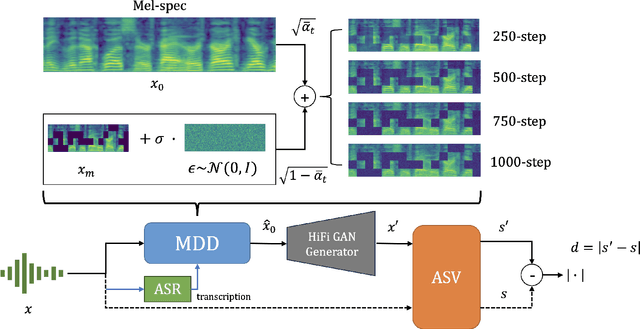
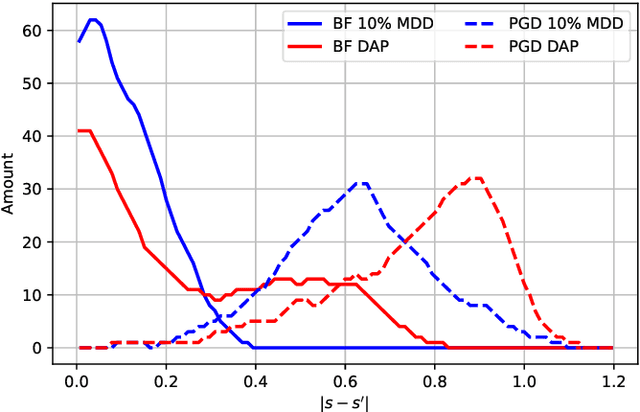
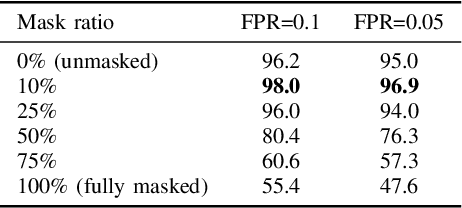

Abstract:Speaker verification systems are increasingly deployed in security-sensitive applications but remain highly vulnerable to adversarial perturbations. In this work, we propose the Mask Diffusion Detector (MDD), a novel adversarial detection and purification framework based on a \textit{text-conditioned masked diffusion model}. During training, MDD applies partial masking to Mel-spectrograms and progressively adds noise through a forward diffusion process, simulating the degradation of clean speech features. A reverse process then reconstructs the clean representation conditioned on the input transcription. Unlike prior approaches, MDD does not require adversarial examples or large-scale pretraining. Experimental results show that MDD achieves strong adversarial detection performance and outperforms prior state-of-the-art methods, including both diffusion-based and neural codec-based approaches. Furthermore, MDD effectively purifies adversarially-manipulated speech, restoring speaker verification performance to levels close to those observed under clean conditions. These findings demonstrate the potential of diffusion-based masking strategies for secure and reliable speaker verification systems.
The Risks and Detection of Overestimated Privacy Protection in Voice Anonymisation
Jul 30, 2025Abstract:Voice anonymisation aims to conceal the voice identity of speakers in speech recordings. Privacy protection is usually estimated from the difficulty of using a speaker verification system to re-identify the speaker post-anonymisation. Performance assessments are therefore dependent on the verification model as well as the anonymisation system. There is hence potential for privacy protection to be overestimated when the verification system is poorly trained, perhaps with mismatched data. In this paper, we demonstrate the insidious risk of overestimating anonymisation performance and show examples of exaggerated performance reported in the literature. For the worst case we identified, performance is overestimated by 74% relative. We then introduce a means to detect when performance assessment might be untrustworthy and show that it can identify all overestimation scenarios presented in the paper. Our solution is openly available as a fork of the 2024 VoicePrivacy Challenge evaluation toolkit.
ASVspoof 5: Design, Collection and Validation of Resources for Spoofing, Deepfake, and Adversarial Attack Detection Using Crowdsourced Speech
Feb 13, 2025Abstract:ASVspoof 5 is the fifth edition in a series of challenges which promote the study of speech spoofing and deepfake attacks as well as the design of detection solutions. We introduce the ASVspoof 5 database which is generated in crowdsourced fashion from data collected in diverse acoustic conditions (cf. studio-quality data for earlier ASVspoof databases) and from ~2,000 speakers (cf. ~100 earlier). The database contains attacks generated with 32 different algorithms, also crowdsourced, and optimised to varying degrees using new surrogate detection models. Among them are attacks generated with a mix of legacy and contemporary text-to-speech synthesis and voice conversion models, in addition to adversarial attacks which are incorporated for the first time. ASVspoof 5 protocols comprise seven speaker-disjoint partitions. They include two distinct partitions for the training of different sets of attack models, two more for the development and evaluation of surrogate detection models, and then three additional partitions which comprise the ASVspoof 5 training, development and evaluation sets. An auxiliary set of data collected from an additional 30k speakers can also be used to train speaker encoders for the implementation of attack algorithms. Also described herein is an experimental validation of the new ASVspoof 5 database using a set of automatic speaker verification and spoof/deepfake baseline detectors. With the exception of protocols and tools for the generation of spoofed/deepfake speech, the resources described in this paper, already used by participants of the ASVspoof 5 challenge in 2024, are now all freely available to the community.
A Generative Framework for Bidirectional Image-Report Understanding in Chest Radiography
Feb 09, 2025



Abstract:The rapid advancements in large language models (LLMs) have unlocked their potential for multimodal tasks, where text and visual data are processed jointly. However, applying LLMs to medical imaging, particularly for chest X-rays (CXR), poses significant challenges due to the need for precise visual-textual alignment and the preservation of critical diagnostic details. In this paper, we propose Multi-Stage Adaptive Vision-Language Tuning (MAViLT), a novel framework designed to enhance multimodal reasoning and generation for CXR understanding. MAViLT incorporates a clinical gradient-weighted tokenization process and a hierarchical fine-tuning strategy, enabling it to generate accurate radiology reports, synthesize realistic CXRs from text, and answer vision-based clinical questions. We evaluate MAViLT on two benchmark datasets, MIMIC-CXR and Indiana University CXR, achieving state-of-the-art results across all tasks. Human evaluations further validate the clinical relevance and utility of MAViLT, making it a robust tool for real-world medical applications. This work demonstrates the feasibility of leveraging LLMs for multimodal medical imaging while addressing key challenges in vision-language integration.
Text-To-Speech Synthesis In The Wild
Sep 13, 2024Abstract:Text-to-speech (TTS) systems are traditionally trained using modest databases of studio-quality, prompted or read speech collected in benign acoustic environments such as anechoic rooms. The recent literature nonetheless shows efforts to train TTS systems using data collected in the wild. While this approach allows for the use of massive quantities of natural speech, until now, there are no common datasets. We introduce the TTS In the Wild (TITW) dataset, the result of a fully automated pipeline, in this case, applied to the VoxCeleb1 dataset commonly used for speaker recognition. We further propose two training sets. TITW-Hard is derived from the transcription, segmentation, and selection of VoxCeleb1 source data. TITW-Easy is derived from the additional application of enhancement and additional data selection based on DNSMOS. We show that a number of recent TTS models can be trained successfully using TITW-Easy, but that it remains extremely challenging to produce similar results using TITW-Hard. Both the dataset and protocols are publicly available and support the benchmarking of TTS systems trained using TITW data.
2D-Malafide: Adversarial Attacks Against Face Deepfake Detection Systems
Aug 26, 2024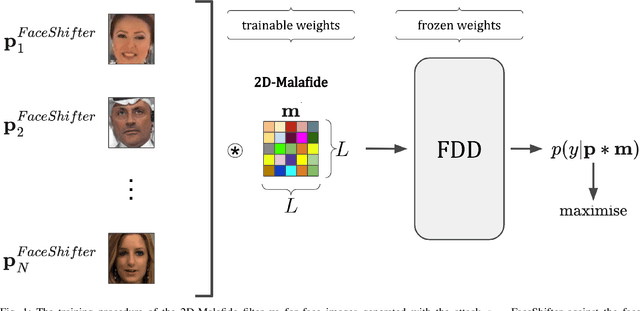
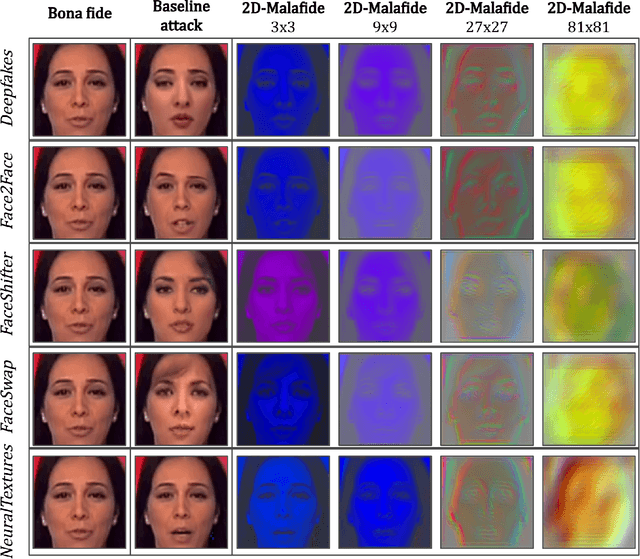
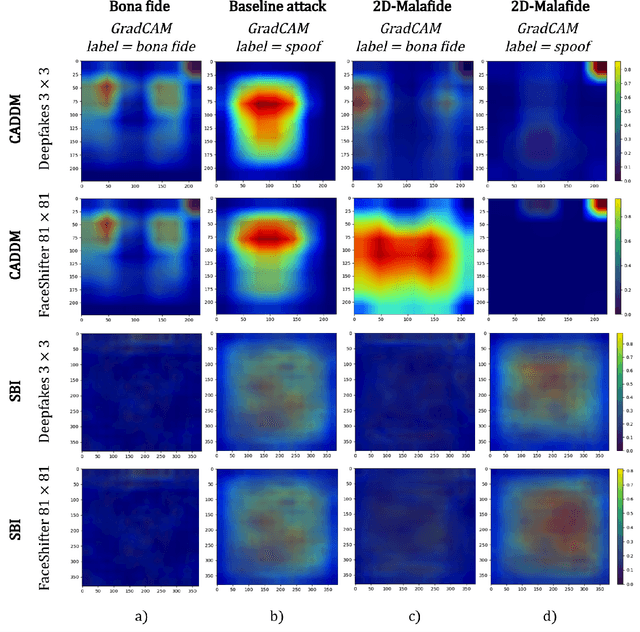
Abstract:We introduce 2D-Malafide, a novel and lightweight adversarial attack designed to deceive face deepfake detection systems. Building upon the concept of 1D convolutional perturbations explored in the speech domain, our method leverages 2D convolutional filters to craft perturbations which significantly degrade the performance of state-of-the-art face deepfake detectors. Unlike traditional additive noise approaches, 2D-Malafide optimises a small number of filter coefficients to generate robust adversarial perturbations which are transferable across different face images. Experiments, conducted using the FaceForensics++ dataset, demonstrate that 2D-Malafide substantially degrades detection performance in both white-box and black-box settings, with larger filter sizes having the greatest impact. Additionally, we report an explainability analysis using GradCAM which illustrates how 2D-Malafide misleads detection systems by altering the image areas used most for classification. Our findings highlight the vulnerability of current deepfake detection systems to convolutional adversarial attacks as well as the need for future work to enhance detection robustness through improved image fidelity constraints.
Malacopula: adversarial automatic speaker verification attacks using a neural-based generalised Hammerstein model
Aug 17, 2024Abstract:We present Malacopula, a neural-based generalised Hammerstein model designed to introduce adversarial perturbations to spoofed speech utterances so that they better deceive automatic speaker verification (ASV) systems. Using non-linear processes to modify speech utterances, Malacopula enhances the effectiveness of spoofing attacks. The model comprises parallel branches of polynomial functions followed by linear time-invariant filters. The adversarial optimisation procedure acts to minimise the cosine distance between speaker embeddings extracted from spoofed and bona fide utterances. Experiments, performed using three recent ASV systems and the ASVspoof 2019 dataset, show that Malacopula increases vulnerabilities by a substantial margin. However, speech quality is reduced and attacks can be detected effectively under controlled conditions. The findings emphasise the need to identify new vulnerabilities and design defences to protect ASV systems from adversarial attacks in the wild.
ASVspoof 5: Crowdsourced Speech Data, Deepfakes, and Adversarial Attacks at Scale
Aug 16, 2024



Abstract:ASVspoof 5 is the fifth edition in a series of challenges that promote the study of speech spoofing and deepfake attacks, and the design of detection solutions. Compared to previous challenges, the ASVspoof 5 database is built from crowdsourced data collected from a vastly greater number of speakers in diverse acoustic conditions. Attacks, also crowdsourced, are generated and tested using surrogate detection models, while adversarial attacks are incorporated for the first time. New metrics support the evaluation of spoofing-robust automatic speaker verification (SASV) as well as stand-alone detection solutions, i.e., countermeasures without ASV. We describe the two challenge tracks, the new database, the evaluation metrics, baselines, and the evaluation platform, and present a summary of the results. Attacks significantly compromise the baseline systems, while submissions bring substantial improvements.
Preserving spoken content in voice anonymisation with character-level vocoder conditioning
Aug 08, 2024


Abstract:Voice anonymisation can be used to help protect speaker privacy when speech data is shared with untrusted others. In most practical applications, while the voice identity should be sanitised, other attributes such as the spoken content should be preserved. There is always a trade-off; all approaches reported thus far sacrifice spoken content for anonymisation performance. We report what is, to the best of our knowledge, the first attempt to actively preserve spoken content in voice anonymisation. We show how the output of an auxiliary automatic speech recognition model can be used to condition the vocoder module of an anonymisation system using a set of learnable embedding dictionaries in order to preserve spoken content. Relative to a baseline approach, and for only a modest cost in anonymisation performance, the technique is successful in decreasing the word error rate computed from anonymised utterances by almost 60%.
 Add to Chrome
Add to Chrome Add to Firefox
Add to Firefox Add to Edge
Add to Edge